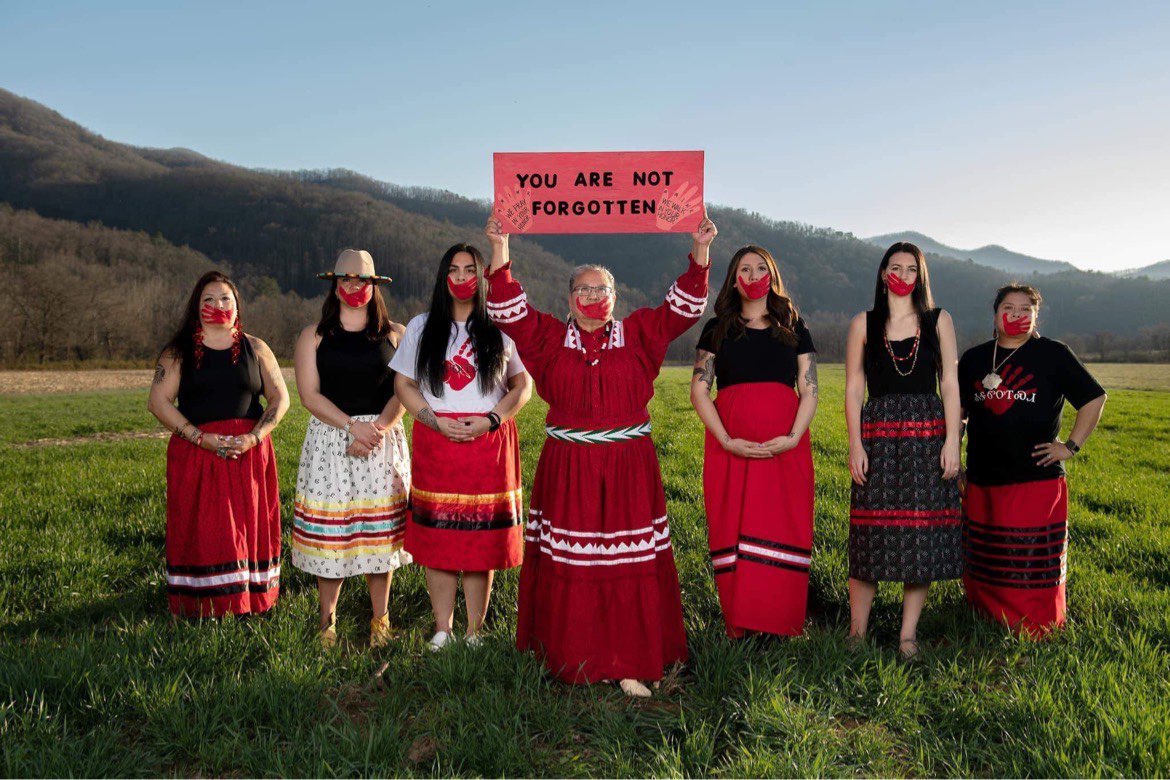Murdered and Missing Indigenous Women movement makes way in WNC

Hannah Styles
hstyles@thesmokymountaintimes.com
The United States continues to face an epidemic, not referring to COVID-19.
There are currently 506 cases of Missing or Murdered Indigenous Women and Girls (MMIWG) identified across 71 selected urban cities, according to the Urban Indian Health Institute. Of those cases, 128 are missing indigenous women, 280 are murdered, 98 have an “unknown status” and the median age of victims is 29 years old.
In 2016, the Urban Indian Health Institute said there were 5,712 Missing or Murdered Indigenous Women and Girls cases reported, but only 116 logged in the Department of Justice’s database. UIHI also identifies the Invisible 153, which represents cases that do not exist in law enforcement records.
You’ve probably heard of the tragic disappearance and murder of Gabby Petito unfolding last fall in Wyoming, a story that gained massive national media attention; but you’ve probably never heard about Tulalip tribal member Mary Johnson, who disappeared while walking on a road in western Washington to a friend’s house in November of 2020.
There were reportedly more than 700 Indigenous women missing in Wyoming alone at the same time as Petito’s disappearance. Media attention is very lacking on coverage for Native American women cases despite the national murder rate being 10 times higher for women living on a reservation and murder being the third leading cause of death for Native American women.
According to MMIWNC.org, North Carolina sees the most violence toward indigenous women in the eastern part of the state. There have been at least 31 Native American women who have gone missing in eastern North Carolina since 1998. Nine Native women in Lumberton, NC alone have disappeared since the early 2000s, three of those from the Lumbee Tribe in 2017. Rhonda Jones and Kirstin Bennet were found murdered on April18th and Megan Oxendine shortly after on June 3rd of 2017, which authorities believe to be connected crimes.
There have been at least 17 cases of Murdered or Missing Indigenous Women of the Eastern Band of Cherokee Indians. Their names are included to remember them and shed light: Jacqueline Davis, Malinda Cato Later, Hermie Elizabeth Sequoyah Queen, Ollie Cucumber Hornbuckle, Bethna Sue Bradley McCoy, Stacy Bigwitch, Mary, Catherine Haymond, Patricia Louise Mount, Martha Joyce Driver Teesateskie, Banita Jumper Gregory, Carol Deanah McCoy, Lucy Wildcat, Lucinda Littlejohn, Tamara Seay, Marie Walkingstick Pheasant, Eva Blythe Blevins, and Danielle Brady.
They were honored with a banner outside of the Eastern Band of Cherokee’s council house in honor of the National Day of Awareness, last year on May 21st.
The Missing and Murdered Indigenous Women campaign started around 2015 to raise awareness and has been gaining momentum ever since making its way across the country.
“The MMIW is currently working on starting a chapter in Cherokee. The movement has been coming across the United States and has now made its way to western North Carolina,” said Sky Sampson, Director of the Cherokee Center at Western Carolina University and a member of the Eastern Band of Cherokee Indian.
Director Sampson recently put together impactful photoshoots to spread awareness about the issue and said the photos will be displayed at the university, at a mental health showcase and her goal is to make them a traveling gallery going to other universities and facilities to continue spreading the movement.
“We want to show support to the movement and planned the photoshoot to bring awareness because some people have no idea,” Director Sampson said.
Sampson gathered three photographers, two from the EBCI and one from WCU to capture the photos, taken at Kituwah Mound, an ancient Native American settlement in Swain County.
“We put the word out to Native women on WCU’s campus and for the first photo shoot we had 30 slots and the second one we had 15 and all were filled both times,” she said.
The photoshoots included all ages of Native American women, dressed in Native attire with a red handprint across their mouth, which is a major symbol among the movement.
“The red handprint symbolizes that many women have been silenced by the violence but now the silenced hand is gone, and they are beginning to speak out,” Sampson said.
With movements like MMIW bringing attention to the issue, media, social media, movies, and television shows have started to include storylines surrounding the topic.
The movies Wind River came out in 2017 with big names like Jeremy Renner, Gil Birmingham, and Elizabeth Olsen and attempted to shed light on repeated murders on a Wyoming Native American reservation. Also, the highly popular still running television show, Yellowstone featured a storyline about one of the leading characters, Monica Dutton, helping find the killers of women on her (fictional) reservation in Montana. Although Hollywood doesn’t always get it right, three Cherokee women are raising awareness through a new podcast called We are Resilient: A MMIW True Crime Podcast, which details the stories of missing and murdered Native American women across the United States to share their story with the world. The first episode began October 26, 2021 and the podcast can be found on Spotify and Apple Music and is definitely worth listening to.
The National Partners Work Group on Missing and Murdered Indigenous Women (MMIW) and the MMIW Family Advisors are organizing a National Week of Action for April 29-May 5, 2022 to call the nation and the world to action in honor of missing and murdered indigenous women. North Carolina’s day of action is April 30, 2022 and MMIW NC is hosting a walk to raise awareness. The WCU Cherokee Center and the surrounding community are working to launch MMIW events and activities in the future.